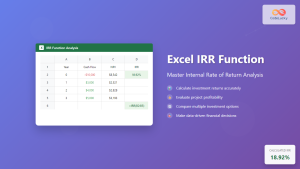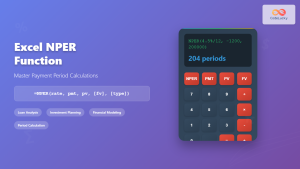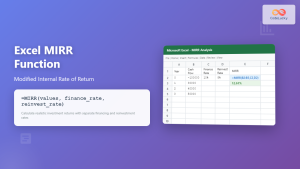NumPy, the fundamental package for scientific computing in Python, provides powerful tools for financial analysis. This article explores NumPy's capabilities for performing Time Value of Money (TVM) calculations, a cornerstone of financial modeling and investment analysis. TVM is the concept that money available at the present time is worth more than the same amount in the future due to its potential earning capacity. NumPy offers efficient and versatile functions to handle these calculations, simplifying complex financial computations.
Present Value (PV) Calculations
The present value (PV) is the current worth of a future sum of money or stream of cash flows, given a specific rate of return. NumPy's np.pv() function calculates the present value of a future cash flow stream.
Syntax
np.pv(rate, nper, pmt, fv=0, when='end')
- rate: The interest rate per period.
- nper: The number of periods.
- pmt: The payment made each period. Can be a fixed amount, or can vary (see examples below).
- fv: The future value. Defaults to 0, representing the desired balance at the end of the investment period.
- when: Specifies whether payments are due at the beginning or end of each period. Default is 'end' (payments are made at the end of each period). Set to 'begin' for payments at the beginning of each period.
Return Value
np.pv() returns the present value of a series of future payments.
Examples
Simple Present Value Calculation
import numpy as np
# Calculate the present value of $1000 received in 5 years at a 5% annual interest rate
pv = np.pv(rate=0.05, nper=5, pmt=0, fv=1000)
print(f"The present value is: {pv:.2f}")
The present value is: -783.53
Present Value of an Annuity
# Calculate the present value of an annuity with annual payments of $1000 for 10 years at a 6% annual interest rate
pv = np.pv(rate=0.06, nper=10, pmt=1000)
print(f"The present value of the annuity is: {pv:.2f}")
The present value of the annuity is: -7360.09
Present Value with a Future Value
# Calculate the present value of an investment that will be worth $100,000 in 20 years with an annual interest rate of 4%
pv = np.pv(rate=0.04, nper=20, pmt=0, fv=100000)
print(f"The present value of the investment is: {pv:.2f}")
The present value of the investment is: -45638.69
Future Value (FV) Calculations
The future value (FV) represents the value of a current investment at a future point in time, assuming a certain rate of return. NumPy's np.fv() function computes the future value of an investment.
Syntax
np.fv(rate, nper, pmt, pv=0, when='end')
- rate: The interest rate per period.
- nper: The number of periods.
- pmt: The payment made each period. Can be a fixed amount, or can vary (see examples below).
- pv: The present value. Defaults to 0, representing the initial investment.
- when: Specifies whether payments are due at the beginning or end of each period. Default is 'end' (payments are made at the end of each period). Set to 'begin' for payments at the beginning of each period.
Return Value
np.fv() returns the future value of a series of payments.
Examples
Simple Future Value Calculation
# Calculate the future value of $1000 invested for 5 years at a 5% annual interest rate
fv = np.fv(rate=0.05, nper=5, pmt=0, pv=-1000)
print(f"The future value is: {fv:.2f}")
The future value is: 1276.28
Future Value of an Annuity
# Calculate the future value of an annuity with annual payments of $1000 for 10 years at a 6% annual interest rate
fv = np.fv(rate=0.06, nper=10, pmt=-1000)
print(f"The future value of the annuity is: {fv:.2f}")
The future value of the annuity is: 13180.79
Future Value with a Present Value
# Calculate the future value of a $5000 investment after 15 years with an annual interest rate of 3%
fv = np.fv(rate=0.03, nper=15, pmt=0, pv=-5000)
print(f"The future value of the investment is: {fv:.2f}")
The future value of the investment is: 7146.72
Payment (PMT) Calculations
The payment (PMT) function calculates the periodic payment required to pay off a loan or reach a future value target.
Syntax
np.pmt(rate, nper, pv, fv=0, when='end')
- rate: The interest rate per period.
- nper: The number of periods.
- pv: The present value.
- fv: The future value. Defaults to 0.
- when: Specifies whether payments are due at the beginning or end of each period. Default is 'end' (payments are made at the end of each period). Set to 'begin' for payments at the beginning of each period.
Return Value
np.pmt() returns the periodic payment amount required to pay off a loan or reach a future value target.
Examples
Loan Payment Calculation
# Calculate the monthly payment required to pay off a $200,000 mortgage over 30 years with a 4% annual interest rate
pmt = np.pmt(rate=0.04/12, nper=30*12, pv=200000)
print(f"The monthly payment is: {pmt:.2f}")
The monthly payment is: -954.83
Annuity Payment Calculation
# Calculate the annual payment required to accumulate $1,000,000 in 20 years at a 5% annual interest rate
pmt = np.pmt(rate=0.05, nper=20, fv=1000000)
print(f"The annual payment is: {pmt:.2f}")
The annual payment is: -29523.64
Number of Periods (NPER) Calculations
The number of periods (NPER) function determines the number of periods needed to achieve a desired future value or to pay off a loan.
Syntax
np.nper(rate, pmt, pv, fv=0, when='end')
- rate: The interest rate per period.
- pmt: The payment made each period.
- pv: The present value.
- fv: The future value. Defaults to 0.
- when: Specifies whether payments are due at the beginning or end of each period. Default is 'end' (payments are made at the end of each period). Set to 'begin' for payments at the beginning of each period.
Return Value
np.nper() returns the number of periods needed to reach a financial goal.
Examples
Loan Term Calculation
# Calculate the number of months needed to pay off a $10,000 loan with a 7% annual interest rate and monthly payments of $250
nper = np.nper(rate=0.07/12, pmt=-250, pv=10000)
print(f"The number of months to pay off the loan is: {nper:.0f}")
The number of months to pay off the loan is: 48
Investment Growth Calculation
# Calculate the number of years needed for a $5000 investment to grow to $10,000 at an annual interest rate of 6%
nper = np.nper(rate=0.06, pmt=0, pv=-5000, fv=10000)
print(f"The number of years to reach $10,000 is: {nper:.0f}")
The number of years to reach $10,000 is: 12
Rate (RATE) Calculations
The rate (RATE) function determines the interest rate needed to achieve a specific financial goal.
Syntax
np.rate(nper, pmt, pv, fv=0, when='end', guess=0.1, tol=1e-06, maxiter=100)
- nper: The number of periods.
- pmt: The payment made each period.
- pv: The present value.
- fv: The future value. Defaults to 0.
- when: Specifies whether payments are due at the beginning or end of each period. Default is 'end' (payments are made at the end of each period). Set to 'begin' for payments at the beginning of each period.
- guess: An initial guess for the interest rate (optional, defaults to 0.1).
- tol: The tolerance level for the calculation (optional, defaults to 1e-06).
- maxiter: The maximum number of iterations for the calculation (optional, defaults to 100).
Return Value
np.rate() returns the interest rate required to achieve the specified financial goal.
Examples
Loan Interest Rate Calculation
# Calculate the annual interest rate required for a $15,000 loan to be paid off in 5 years with monthly payments of $300
rate = np.rate(nper=5*12, pmt=-300, pv=15000)
print(f"The annual interest rate is: {rate:.4f}")
The annual interest rate is: 0.0567
Investment Rate Calculation
# Calculate the annual interest rate needed for a $1000 investment to grow to $2000 in 10 years
rate = np.rate(nper=10, pmt=0, pv=-1000, fv=2000)
print(f"The annual interest rate is: {rate:.4f}")
The annual interest rate is: 0.0718
Conclusion
NumPy's financial functions provide a powerful and efficient way to perform Time Value of Money calculations. They offer a streamlined approach to complex financial analysis, allowing you to model investments, evaluate loans, and make informed financial decisions. By leveraging these functions, you can unlock the power of NumPy for financial modeling and gain a deeper understanding of the time value of money.



















